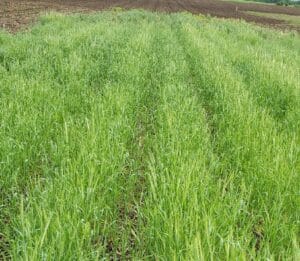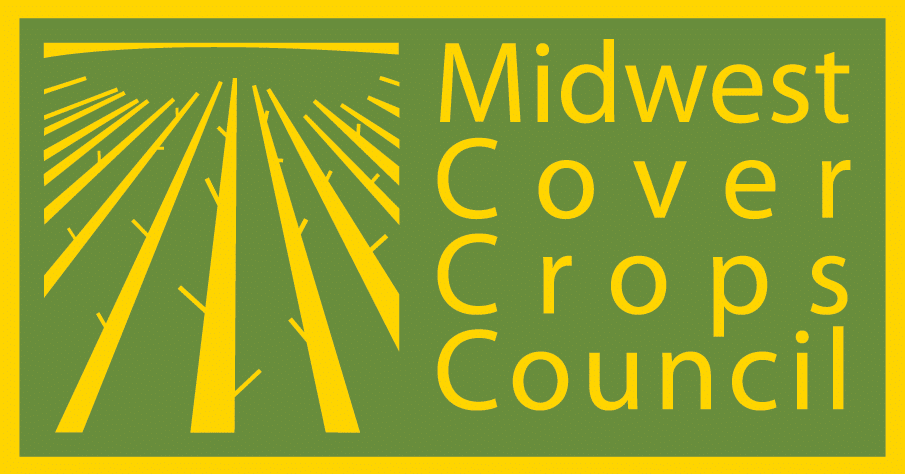Midwest Cover Crops Council (MCCC-114)
This publication is intended to provide a starting point for farmers who are new to growing cover crops. With experience, farmers may fine-tune the use of cover crops for their systems.
Introduction
Fitting cover crops into a corn-soybean rotation in Minnesota can be challenging due to weather constraints that result in a short growing season. Typically, there is little to no time to plant a cover crop and have appreciable growth after corn grain or soybean harvest. Planting a cover crop after small grains, a canning crop, or corn silage will often provide a wider window for establishment before a killing freeze. Since the dominant cropping system in Minnesota is the two-year corn-soybean rotation, this recipe provides an introductory approach for integrating a cereal rye cover crop into the corn year of the rotation.
Planning and Preparation
- Planning—Educate yourself. Go to field days, learn from farmers who are currently planting cover crops, read about cover crops, check out University of Minnesota cover crop research, and work with your local Natural Resources Conservation Service (NRCS) and Soil and Water Conservation District. Start small, and choose a field that has low weed pressure to create the best conditions for success. Consult with your crop insurance representative to ensure planned practices will not affect your insurance coverage.
- Corn planting—It may be useful to avoid late-maturity hybrids when planning to interseed a cover crop as this could allow an earlier planting date for the cover crop (if seeding in the fall) and more time for establishment prior to winter.
- Residual herbicides—Manage for optimal weed control when adding a cover crop to your cropping system. Although commonly used herbicides in a corn-soybean rotation can negatively impact cover crop establishment, cereal rye can tolerate many of these herbicides. However, if the cereal rye is to be grazed or used for feed or forage, you must follow the rotational crop restrictions listed on the label of any applied herbicides. (In the Resources section, see Managing Risk When Using Herbicides and Cover Crops in Corn and Soybean.)
- Seed purchase—Order cover crop seed early from a reputable source. Use good-quality tagged seed that has been cleaned and tested for germination and weed seed contamination. Avoid planting seed of unknown origin and quality. Named varieties can produce greater growth and have more predictable development, but they are usually more expensive than VNS (variety not stated) seed.
Fall Work
- Interseeding into corn—To maximize rye growth and soil protection, planting rye into standing corn around the R5 (dent) to R6 (physiological maturity) stage of corn is ideal. At this point, the corn canopy is starting to open, which will allow more sunlight to reach the ground to aid in cereal rye establishment. Broadcast seed by ground using a high-clearance seeder or by air using a plane or helicopter.
- Planting after harvest—Alternatively, rye can be drilled after corn, although not too much growth will be attained. Plant the cereal rye to a recommended depth of 0.75 to 1.50 inches. Drilling allows for good seed-to-soil contact and enhanced establishment as compared to broadcasting seed. Adequate moisture after seeding will aid in successful establishment.
- Seeding rate—For broadcasting cereal rye, use a minimum seeding rate of 83 lbs./acre of pure live seed (PLS). If drilling, use a minimum seeding rate of around 55 lbs./acre of PLS. If you receive funding from an agency or organization to plant a cover crop, double-check with them to ensure your seeding rate complies with any standards they might have.
- Strip-tillage or no-tillage—It is easier to incorporate cover crops into a corn-soybean rotation when soybeans are no-tilled or strip-tillage is used. Full-width tillage in the fall will not allow for much cover crop growth, thus eliminating many of the potential benefits of planting a cover crop.

Spring Work
- Scouting—In the spring, scout the cereal rye cover crop to determine how well it is growing. If rainfall is below normal or the long-term weather forecast calls for a drier season, monitor soil moisture in case earlier termination is needed.
- Termination timing—Terminate the cereal rye in the spring when plants are actively growing and no more than 12 inches tall or at least 10 days prior to planting soybean—whichever comes first. Cereal rye can grow quickly in warm weather and be more difficult to control once it reaches the boot stage or is taller than 18 inches. Allowing at least 10 days between termination and planting will help ensure successful control. Check with your insurance agent to be sure you are in compliance with USDA-NRCS Cover Crop Termination Guidelines (see Resources).
- Termination herbicide—Cereal rye can be easily terminated with a full rate of glyphosate (minimum of 1 lb. acid equivalent [ae]/acre) after dormancy breaks in the spring. Effectiveness and rapidity of termination improves if rye is rapidly growing, applications are made on a sunny day, and air temperatures are warmer (>60°F during the day and >40°F at night). Applications should be made during the day and at least four hours prior to sunset.
- Soybean planting—It is usually best to no-till plant soybean into the dead or dying cereal rye cover crop. Most modern planters and drills are fully capable of planting soybean under these conditions. If wet or windy weather delays termination of the cereal rye prior to planting, it may be better to plant into standing green plants versus into large plants that are dead or dying and that have fallen onto the soil surface, forming a thick mat of residue. Check planting depth and seed furrow closure shortly after beginning to plant in case any planter adjustments are needed.
Resources
University of Minnesota Extension Cover Crops Website
Post Soybean, Going to Corn: Use Oats (Minnesota Cover Crop Recipe series, MCCC-115)—available from the Midwest Cover Crops Council
USDA-NRCS Cover Crop Termination Guidelines
Managing Risk When Using Herbicides and Cover Crops in Corn and Soybean (University of Minnesota Extension)
Cover Crops and Federal Crop Insurance (USDA Risk Management Agency Fact Sheet)
Authors
Lizabeth Stahl, University of Minnesota Extension; Anna Cates, University of Minnesota Extension; Axel Garcia y Garcia, University of Minnesota Extension; and M. Scott Wells, University of Minnesota Extension (Note: This publication was adapted with consent from MCCC under a joint project to produce customized introductory guidance about cover crops for all member states/provinces.)
Reviewers and Contributors
Marisol Berti, North Dakota State University; Frank Forcella, USDA-ARS; Eileen Kladivko, Purdue University; Anna Morrow, Midwest Cover Crops Council; and Bruce Potter, University of Minnesota Extension
The Midwest Cover Crops Council (www.https://www.midwestcovercrops.org) aims to facilitate widespread adoption of cover crops throughout the Midwest by providing educational/outreach resources and programs, conducting new research, and communicating about cover crops to the public.
Funding for this project was provided by McKnight Foundation.
October 2019
The U.S. Department of Agriculture (USDA) prohibits discrimination in all its programs and activities on the basis of race, color, national origin, age, disability, and where applicable, sex, marital status, familial status, parental status, religion, sexual orientation, genetic information, political beliefs, reprisal, or because all or a part of an individual’s income is derived from any public assistance program. (Not all prohibited bases apply to all programs.) Persons with disabilities who require alternative means for communication of program information (Braille, large print, audiotape, etc.) should contact USDA’s TARGET Center at (202) 720-2600 (voice and TDD). To file a complaint of discrimination write to USDA, Director, Office of Civil Rights, 1400 Independence Avenue, S.W., Washington, D.C. 20250-9410 or call (800) 795-3272 (voice) or (202) 720-6382 (TDD). USDA is an equal opportunity provider and employer. ©2019 by MCCC. All rights reserved.
